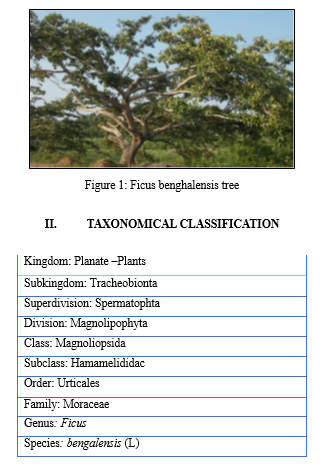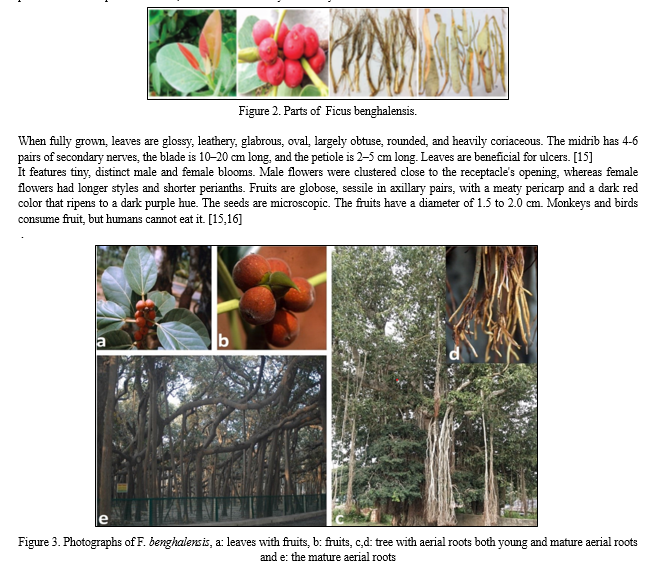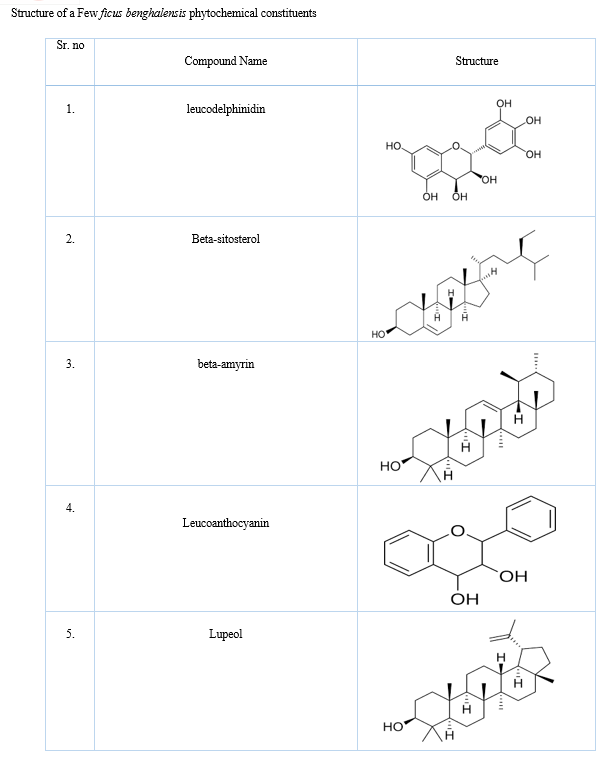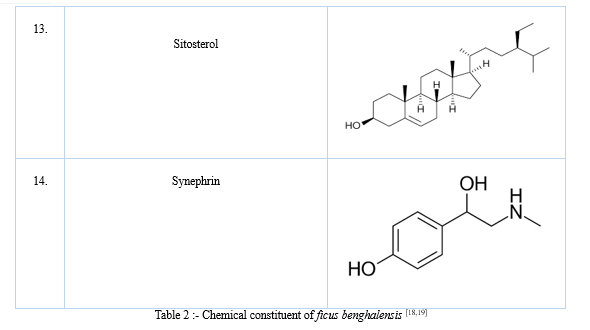Ijraset Journal For Research in Applied Science and Engineering Technology
- Home / Ijraset
- On This Page
- Abstract
- Introduction
- Conclusion
- References
- Copyright
There are diverse varieties of plants and trees with humongous medicinal properties.
Authors: Ms. Sonal R. Barde, Dr. Deepa S. Mandlik, Ms. Neha S. Tikhile
DOI Link: https://doi.org/10.22214/ijraset.2024.63796
Certificate: View Certificate
Abstract
There are diverse varieties of plants and trees with humongous medicinal properties. Indian and other ancient civilizations were leveraging these plants for curing and treating various diseases and ailments. One such tree with remarkable medicinal properties is the Ficus benghalensis, also known as the Indian Banyan Tree. Ficus benghalensis L. (Moraceae) is used as traditional medicine in South Asian countries for the treatment of various ailments. The main aim of this review was to collect and analyze the traditional uses and scientific information on the phytochemistry and pharmacological activities of different plant parts of F. benghalensis. Information on its ethnomedicinal uses was collected from published books, book chapters, and research papers on ethnobotanical surveys. Scientific information about phytochemistry and pharmacology was retrieved from online bibliographic databases such as PubMed, Sci Finder, Web of Science, and Google Scholar. Regarding traditional uses, various plant parts of F. benghalensis were found to be used in Ayurveda, Siddha and other traditional medicine systems in South Asia. Ficus benghalensis is an important medicinal plant that has several bioactive compounds. The stem bark was used mostly for the treatment of diabetes, diarrhoea, and dysentery. The latex is used for the treatment of wounds, burns, and rheumatism. Fruits are edible and are used as a tonic. Regarding phytochemistry, leucoanthocyanidin derivatives, and triterpenes were reported from the stem bark, and triterpene derivatives and phenolic compounds including flavonoids were reported from the leaves. The present review is, therefore, an initiative to give a broad survey of the literature on its phytochemistry, pharmacognosy, traditional and pharmacological uses.
Introduction
I. INTRODUCTION
Since the beginning of human history, people have used a variety of plants for a variety of purposes, including food, medicine, and other sources of income. Worldwide, plants have played a major role in the evolution of human societies. Numerous plant and tree species possess immense therapeutic benefits.[1] These herbs were used by the Indians and other ancient civilizations to treat and cure a wide range of illnesses. Because they are abundant sources of therapeutic value that can be utilized in drug development, medicinal plants form the foundation of traditional medicine. [2] India is referred to as the world's medical garden. Its diverse range of environments supports a large diversity of plant species. Both tribal populations and traditional medical systems in India employ these medicinal plants in their healing rituals. The advancement of knowledge to cure diseases has resulted in the development of novel plant-derived medications. [1,2,3]
India has the greatest traditional and local knowledge base of medicinal plants in the world, and the Himalayas is one of the world's megabiological zones. [4] Since ancient times, plants have been used in phytomedicine due to their robust biochemistry, which allows man to extract an amazing variety of industrial compounds from them. Ancient scholarly works, such as the Atharva-Veda (an Indian religious text), Ayurveda (an Indian traditional medical system), and others, provided a wealth of knowledge on preventive and therapeutic medications. [5] Among the world's 17 largest countries with the highest biodiversity is India. There are 40,000–20,000 plants with therapeutic properties among the 40,000 plant species. [6]
The majority of poor nations employ traditional medicines and medicinal plants to maintain good health, according to a 1996 report by the United Nations Educational, Scientific, and Cultural Organisation (UNESCO). The traditional medical systems of Ayurveda, Siddha, Unani, homeopathy, yoga, and naturopathy are widely acknowledged in India. [7]
Ficus benghalensis, a huge evergreen tree, is part of the Moraceae family. It's also known as the "Indian Banyan Tree". It is one of four sacred trees known as "Nalpamara" (Ksirivarkas) that are intended to be planted around homes and temples. Their ever-expanding branch represents eternal life; hence it is regarded as sacred. Plants produce the bulk of chemical substances that perform essential biological processes. [8] The banyan tree, one of history's most revered trees, possesses qualities that can cure some of the most terrible diseases [8,9].

A. Species
- Ficus Benghalensis (Indian banyan or the wish fulfilling tree)
- Ficus Religiosa (Bodhi tree or Sacred tree)
- Ficus Racemosa (Cluster fig or Goolar fig)
- Ficus Carica (Common fig or Fig) [10]
B. Religious Background
The banyan is considered sacred by Hindu deities such as Vishnu, Brahma, Kali, Lakshmi, and Kubera, and it symbolizes Lord Shiva. The Trimurti—Vishnu, Brahma, and Shiva—is represented by the tree. Shiva is thought to be the branches, Brahma the roots, and Vishnu the bark. In many Indian communities, the banyan tree is revered by childless people because it symbolizes life and fertility, and it is never chopped down [11].
C. Distribution
It grows well in rainforests, monsoon areas, tropical and semi-tropical climates, and areas with moderate to abundant rainfall. Its development is ideally suited to humid air, moist soil, hardiness, tolerance to drought, and moderate cold. Native to South Asia, the banyan tree is primarily found in Pakistan, India, and Sri Lanka. It is frequently planted in the vicinity of temples and other sites of religious significance. [10,11] Both Hindus and Buddhists regard it as a sacred tree. The banyan tree is commonly grown across the tropics of both the New and Old Worlds in municipal parks and botanical gardens [11].
Approximately 750 plant species in the genus Ficus can be found in most tropical and subtropical forests worldwide. The wide range of behaviors among the species in this genus is noteworthy [12,13,14].
D. Morphology
The banyan tree is enormous, reaching a height of approximately 100 feet and spreading its branches over several acres as its giant limbs are supported by prop roots. When young, the smooth green bark turns greyish white as it ages, and when it is cut, it turns pink. The wood is porous and soft, and the latex is milky and sticky. [14]

III. TRADITIONAL APPLICATIONS
Different components of the tree have been found to have medicinal effects; the leaves are beneficial for ulcers, the aerial roots are good for gonorrhea, and the seeds and fruits are cooling and nourishing. Ficus bengalensis roots are used to treat intractable vomiting, and an infusion of its bark is considered a tonic and astringent. It is also used to treat diarrhea, dysentery, and diabetes. In India, Ayurvedic practitioners use the milky liquid (latex) of Ficus bengalensis stem bark to cure rheumatism and other inflammatory conditions. The plant's bark is utilized in Ayurvedic medicine to cure Diabetes [17].
IV. BIOACTIVE SUBSTANCES AND PHYTOCHEMISTRY
Plants contain phytochemicals in the form of secondary metabolites, which can be used to treat a variety of human illnesses. Many phytochemical elements responsible for F. benghalensis' different medicinal and pharmacognostic characteristics have been discovered in various areas of the plant during preliminary phytochemical investigations. They are rich in terpenes, flavonols, flavonoids, triterpenoids, methyl esters, sterols, coumarins, carbohydrates, amino acids, saponins, and tannins [18].
Stem bark contains a number of anthocyanidin derivatives (methyl ethers of leucodelphinidin-3-O-L-rhamnoside, lecocyanidin-3-O-D-galactosylcellobioside) as well as aliphatic long chain ketones (pentatriacontan-5-one). The leaves include 9.63% crude protein, 26.84% crude fibre, 2.53% calcium oxalate, and 0.4% phosphorus. The numerous qualitative chemical tests of ethanol and aqueous leaf extracts reveal a high concentration of sterols, flavanoids, phenol, tannins, and saponins [18,19].
Table 1 covers F. benghalensis' phytoconstituents and ethanomedical uses.
|
Plant part used |
Phytochemical class |
Phytochemical constituents |
Ethnomedicinal application |
|
Leaf |
phenols, flavonols & flavonoids, Leucoanthocyanidin Terpenoids |
Gallic acid, theaflavins, catechin, bergapten, rutin, leucodelphinidin, Beta-sitosterol, lupeol, beta-amyrin,2 traxasten-3-ol, Friedelin |
Treats chronic diarrhea, vomiting, nausea, vaginal infections dysentery, wounds, abscesses, pimples, and other skin disorders |
|
Stem bark |
Anthocyanin derivatives, Phenolics,Terpenes/terpenoids Esters |
Tannin, Lupeol, beta-sitosterol and saponin, leucoanthocyanin, leucoanthocyanidin.
|
Infusion of stem used in treating nervous disorders, diarrhea, asthma, nervous disorders, urinary problems, The milky sap is used to treat snake bites, gonorrhea, diarrhea, joint pain, dermatitis diabetes. Als it increases memory power and acts as a natural immunity booster. |
|
Aerial roots |
Terpenes/terpenoids |
Amyrin acetate, lupeol, lanosterol, azelaic acid cyanuric acid, synephrin Myristic acid, palmitic acid,sitosterol,ergosterol acetate. |
Treat jaundice, body and joint pain, leucorrhoea, diarrhea, vomiting, and excessive hair fall. Reduce excessive blood flow during mensturation. |
|
Buds, seeds and fruits |
Proteins, Amino acids |
Methionine, arginine, cysteine, glutathione, glutamine, tryptophan, hydroxyproline Hexadecanoic acid, D-glucose, D-fructose, D-arabinose.
|
Diarrhoea, dysentery, biliary complications. |
Table 1 lists of phytoconstituents of F. benghalensis with its ethanomedical applications. [18]



V. PHARMACOLOGICAL ACTIVITY
A. Anti-inflammatory Activity
In experimental animals, the anti-inflammatory properties of ethanolic and petroleum ether bark extracts were assessed through oral administration of dosages of 300 and 600 mg/kg/day of body weight. Rats with hind paw edoema caused by carrageenan were given extracts to study for their anti-inflammatory properties, and three hours after injection, the volume of the paw was measured plethysmometrically. The carrageenan-induced paw edoema in rats was considerably decreased by the ethanolic and petroleum ether extracts of FB. Animal models were used to assess the analgesic and anti-inflammatory properties of FB's methanolic extract (MEFB) and aqueous extract (AEFB). According to preliminary findings, MEFB therapy has a significantly higher potential for reducing inflammation than AEFB.It was discovered that MEFB's anti-inflammatory effectiveness in both acute and sub-chronic models of inflammation was significant. [20,21]
B. Anthelmintic Activity
The methanolic, aqueous, chloroform, and petroleum ether extracts of FB were investigated for their ability to cause earthworm paralysis and death. It was discovered that every extract killed the earthworms (Vermicidal) in addition to paralysing them (Vermifuge). It was discovered that the earthworm could be executed more successfully with the aqueous and methnolic extract. [22,23]
C. Anti-diarrhoeal Activity
Ficus bengalensis (bark) ethanol extract was tested for antidiarrheal properties against many rat experimental types of diarrhoea. Plant extract significantly inhibited the castor oil-induced diarrhoea that rats developed. In rat testing using charcoal meals, these extracts also significantly decreased the motility of the gastrointestinal system. [23,24]
D. Anti-stress & Anti- Allergic
Various preparations of Ficus bengalensis bark were tested for their anti-allergic and anti-stress properties in asthma using milk-induced leucocytosis and eosinophilia. In the order listed, aqueous, ethanol, and ethyl acetate extracts significantly reduced leucocytes and eosinophils, although petroleum ether and chloroform extracts did not. This demonstrates the use of polar components from F. bengalensis bark as anti-stress and antiallergic agents in asthma. [25,26]
E. Anti- oxidant Activity
The extract's antioxidant activity was assessed using DPPH radical scavenging activity, hydroxyl radical scavenging activity, reducing capacity, hydrogen peroxide activity, and total phenolic content using Folin-Ciocalteu's phenolic reagent. The extract significantly reduced DPPH radical (96.07%) at 250 μg mL-1 concentration and hydrogen peroxide (69.23%) at 1000 μg mL-1 concentration. When compared to other chemicals, the extract outperforms them. This demonstrates the extract's scavenging action. [27,28]
F. Anti-tumor Activity
The chloroform extract of the fruit of Ficus benghalensis showed toxicity in the brine shrimp (Artemiasalina) bioassay (LC50 < 1000μg/ml). It also demonstrated anti-tumor efficacy in the potato disc bioassay (% tumour inhibition > 20%). The other examined extracts revealed no significant suppression of calcium absorption in rat pituitary cells GH4C1. The findings corroborate the traditional use of these plants in folk medicine to treat respiratory ailments and certain skin diseases. [29,30]
G. Anti- diabetic Activity
The aqueous extract of FB bark was shown in this study to have significant hypoglycemia and hypocholesterolemic effects on alloxan-induced, mild, and acute diabetes in rabbits. The dose of 300mg kg−1 resulted in a maximum decrease of 43.8 and 40.7% in BGL during FBG and glucose tolerance test (GTT) tests of normal rats, respectively.
The hypoglycemic impact in normoglycemic and antidiabetic effects in sub- and mild-diabetic animals of aqueous extract of aerial roots of Ficus bengalensis are attributed to the presence of these glycemic ingredients in high concentrations relative to other elements. [31,32,33]
H. Analgesic and anti-pyretic Activity
Ficus benghalensis bark was found to have antipyretic action against Brewer's yeast-induced pyrexia in rats. The extract and Aspirin significantly reduced analgesic efficacy for hot plate and tail immersion methods, as well as antipyretic activity for Brewer's yeast-induced pyrexia in rats. The presence of flavonoids and phenolic chemicals may explain the increased analgesic effects of the studied extracts. The bark extracts of Ficus benghalensis have analgesic and antipyretic properties, possibly due to bioactive components. [34]
I. Wound Healing Property
Although several plants have been experimentally evaluated for wound healing activities in various pharmacological models and patients, their full potential remains unknown. Occasionally, active chemical components were found. Ficus bengalensis has been used in Ayurvedic medicine for wound healing and has been evaluated in several models. [35]
J. Immunomodulatory Activity
The aerial roots of Ficus benghalensis were tested for immunodulatory activity utilising an in vitro polymorpho nuclear leukocyte (human neutrophile) function test. In vivo tests with rats were conducted to assess the immunological modulatory activities of the methanol extract. The extracts were examined for hypersensitivity and hem agglutination reactions with sheep red blood cells (SRBC) as an antigen. In vivo investigations showed that methanol extracts at doses of 100 and 200 mg/kg increased hypersensitivity to the SRBC antigen. In animal tests, dosages of 100 and 200 mg/kg resulted in significantly higher antibody titers to SRBC. [36]
K. Hypolipidemic Activity
Three groups of rabbits were provided cholesterol suspension in ground nut oil (100mg/kg/day), while another group was fed Ficus benghalensis bark extract (50mg/kg/day).
Bark extract treatment significantly lowered serum cholesterol (59%), triacylglycerol (54%), and lipid peroxidation. After cholesterol feeding, antioxidant enzymes such as superoxide dismutase, catalase, and glutathione peroxidase showed significant increases, which were previously suppressed in other groups. This study found that a water extract of Ficus benghalensis bark has significant hypolipidemic properties. [37]
L. Anti-microbial Activity
Ficus benghalensis fruit extract (0.5 mg/disc) inhibited the bacterium Micrococcus luleus (18-26 mm inhibition zone), while kanamycin (100 μ.g/disc), streptomycin (100 μg/disc), and penicillin (5 μg/disc) did not. The fruit extract inhibited Streptococcus faecalis and Streptococcus faecium with an inhibition zone of 17-20 mm. Bacillus cereus, B. megaterium, Staphylococcus aureus, Streptococcus epidermis, Streptococcus lactis, Escherichia coli, Klebsiella pneumonia, Proteus vulgaris, and Pseudomonas aeruginosa were all inhibited to varying degrees (16-19 mm inhibition zone). [38]
Conclusion
This review contains useful information regarding the morphology, phytochemistry, phytochemical analysis, and pharmacological properties of Ficus benghalensis. The review identifies 5,7-Dimethyl ether of leucocyanidin 3-O-? -D-galactosylcellobioside, Quercetin 3-O-galactoside, ?-Amyrin acetate, Lupeol, ? -Sitosterol-?-D-glucoside, and Myristic acid as the primary constituents of these species, which were analysed using different methodologies. These are commonly employed as antioxidants, antitumors, analgesics and antipyretics, anthelmintics, immunomodulators, antimicrobials, anti-inflammatory agents, and anti-diabetics. However, a methodical and scientific approach is required to fully realise the potential of these species. Only a few pharmacological investigations on animals have demonstrated that extracts and isolated substances have promising antidiabetic properties, but the underlying processes have not been thoroughly investigated. Future studies should also focus on the study of potential toxicity and pharmacokinetic parameters, and clinical studies.
References
[1] Saravanam M, Elankani P, Ramachandran S. Characterization of Traditionally Useful Herbal Mineral from Ficus benghalensis Leaves for Skin Disorders. Indian J Pharm Sci. 2024;86(3):851-9. [2] Singh P, Dhankhar J, Kapoor RK, Kumar D, Bhatia S, Al-Harrasi A, Sharma A. Ficus benghalensis—A comprehensive review on pharmacological research, nanotechnological applications, and patents. Journal of Applied Pharmaceutical Science. 2023 Oct 4;13(10):059-82. [3] Logesh R, Sathasivampillai SV, Varatharasan S, Rajan S, Das N, Pandey J, Devkota HP. Ficus benghalensis L.(Moraceae): a review on ethnomedicinal uses, phytochemistry and pharmacological activities. Current Research in Biotechnology. 2023 Jan 1;6:100134. [4] Agrawal T. Ethnobotany of the Ficus Benglensis. Annals of Reviews & Research. 2018;1(3):64-5. [5] Gopukumar ST, Praseetha PK. Ficus benghalensis Linn–the sacred Indian medicinal tree with potent pharmacological remedies. Int. J. Pharm. Sci. Rev. Res. 2015 May;32(37):223-7. [6] Meena AK, Meena J, Jadhav A, Padhi MM. A review on Hiptage benghalensis (Madhavilata) used as an Ayurvedic drug. Asian Journal of Pharmacy and Technology. 2014;4(1):28-31. [7] UNESCO C. Health orientation Texts world decade for cultural development 1988-1997. Document CLT/DEC/PRO-1996, Paris, France: UNESCO Digital Library; 1996. [8] Kumar N, Wani ZA, Dhyani S. Ethnobotanical study of the plants used by the local people of Gulmarg and its allied areas, Jammu & Kashmir, India. International Journal of Current Research in Bioscience and Plant Biology. 2015;2(9):16-23. [9] Sharma Arti, Sharma Arti, S. V. Kumar, Sharma Pooja Sharma Pooja, and Chandel Sangeeta Chandel Sangeeta.Studies on traditional knowledge of ethnomedicinal plants in Jawalamukhi, Himachal Pradesh, India. (2014): 6-12. [10] Somashekhar M, Mahesh AR. Botanical study of four Ficus species of family Moraceae: a review. Int J Univ Pharm Bio Sci. 2013;2:558-70. [11] Verma S. A review study on phytochemical and pharmacological properties of Ficus benghalensis (Indian Banyan tree). International Journal of Science Engineering and Technology. 2016;2(4):73-5. [12] Satyavati Gv, Raina MK, Sharma M. Medicinal plants of India. Indian Council of Medical Research; 1987. [13] Bakshi DNG, Pal Dc, Sensarma P, A Lexicon of Medicinal Plants in India, Naya Prokash, 2001. [14] Mandal S, Shete R, Kore K, Otari K, Kale B, Manna A. Indian national tree (Ficus bengalensis). Int. J. Pharm. Life Sci.. 2010;1:268-73. [15] Somashekhar M, Nayeem N, Mahesh AR. International Journal of universal pharmacy and sciences. [16] Patil VV, Pimprikar RB, Patil VR. Pharmacognostical studies and evaluation of anti-inflammatory activity of Ficus bengalensis Linn. Journal of Young Pharmacists. 2009 Jan 1;1(1):49. [17] Spiegler V, Liebau E, Hensel A. Medicinal plant extracts and plant-derived polyphenols with anthelmintic activity against intestinal nematodes. Natural product reports. 2017;34(6):627-43. [18] Bhaskara Rao Kv, Ojha V, Preeti, Kumar G, Karthik L. Phytochemical composition and antioxidant activity of Ficus benghalensis (Moraceae) leaf extract. Journal of Biologically Active Products from Nature. 2014 May 4;4(3):236-48. [19] Murugesu S, Selamat J, Perumal V. Phytochemistry, pharmacological properties, and recent applications of Ficus benghalensis and Ficus religiosa. Plants. 2021 Dec 14;10(12):2749. [20] Patil VV, Patil VR. A comparative evaluation of anti-inflammatory activity of the bark of Ficus bengalensis in plants of different age. Journal of Basic and Clinical Pharmacy. 2010 Mar;1(2):107. [21] Vikas VP, Bhangle SC, Narkhede BS, Jawle NM, Patil RV. Analgesic and antipyretic activities of Ficus benghalensis bark. International Journal of Pharmaceutical Research. 2010;2(2):25-30. [22] Aswar M AU, Watkar B, Vyas M, Wagh A., Gujar KN, Anthelmintic activity of Ficus bengalensis IJGP, 2(3), 2008. [23] Gaherwal S. Anti-bacterial activity of Ficus benghalensis (Banyan) fruit extract against different bacteria. [24] Uma B, Prabhakar K, Rajendran S. Invitro antimicrobial activity and phytochemical analysis of Ficus religiosa L. and Ficus bengalensis L. against Diarrhoeal Enterotoxigenic E. coli. Ethnobotanical leaflets. 2009;2009(4):7. [25] Taur DJ, Nirmal SA, Patil RY, Kharya MD. Antistress and antiallergic effects of Ficus bengalensis bark in asthma. Natural product research. 2007 Dec 1;21(14):1266-70. [26] Jahagirdar AQ, Hugar S, Patil VP, Nanjappaiah AK. Screening of Antistress activity of Ficus benghalensis Fruit extract. Research Journal of Pharmacy and Technology. 2020;13(1):191-6. [27] Saloni J, Sakthavel J. Evaluation of antioxidant and anticancer potential of flavonoids from aerial roots of Ficus benghalensis Linn. International Journal of Pharmaceutical Research (09752366). 2019 Jan 1;11(1). [28] Sharma RK, Chatterji S, Rai DK, Mehta S, Rai PK, Singh RK, Watal G, Sharma B. Antioxidant activities and phenolic contents of the aqueous extracts of some Indian medicinal plants. J Med Plants Res. 2009 Nov 1;3(11):944-8. [29] Shabi Ruskin R, Priya Kumar V, Gopukumar ST, Praseetha PK, Evaluation of Phytochemical, Anti-Bacterial and Anti Cancerous Activity of Cissus quadrangularis, Int J Pharm Sci Rev Res, 28(1), 2014, 12-15. [30] Joshi DG, Jat RK, Patil SB. In vitro protein denaturation and membrane stabilising anti-arthritic activity of aqueous extracts of bark of Ficus benghalensis L. against methotrexate. The Pharma Innovation Journal. 2021;10(4):689-92. [31] Khanal P, Patil BM. Consolidation of network and experimental pharmacology to divulge the antidiabetic action of Ficus benghalensis L. bark. 3 Biotech. 2021 May;11(5):238. [32] Deepa P, Sowndhararajan K, Kim S, Park SJ. A role of Ficus species in the management of diabetes mellitus: A review. Journal of ethnopharmacology. 2018 Apr 6;215:210-32. [33] Otunola GA, Afolayan AJ. A review of the antidiabetic activities of ginger. Ginger cultivation and its antimicrobial and pharmacological potentials. 2020 Feb 19. [34] Thakare VN, Suralkar AA, Deshpande AD, Naik SR. Stem bark extraction of Ficus bengalensis Linn for anti-inflammatory and analgesic activity in animal models 2010 [35] Garg VK, Paliwal SK. Wound-healing activity of ethanolic and aqueous extracts of Ficus benghalensis. Journal of advanced pharmaceutical technology & research. 2011 Apr 1;2(2):110-4. [36] Bhanwase AS, Alagawadi KR. Antioxidant and Immunomodulatory activity of Hydroalcoholic extract and its fractions of leaves of Ficus benghalensis Linn. Pharmacognosy Research. 2016 Jan;8(1):50. [37] Sharma R. Hypoglycemic and Hypolipidemic effect of ficus benghalensis linn bark laticiferous sap and syzygium cumini seed extract in alloxan induced diabetes mellitus in rats (Doctoral dissertation, Department of Veterinary Pharmacology and Toxicology, OUAT, Bhubaneswar)2020. [38] Shim KH, Sharma N, An SS. Mechanistic insights into the neuroprotective potential of sacred Ficus Trees. Nutrients. 2022 Nov 9;14(22):4731.
Copyright
Copyright © 2024 Ms. Sonal R. Barde, Dr. Deepa S. Mandlik, Ms. Neha S. Tikhile. This is an open access article distributed under the Creative Commons Attribution License, which permits unrestricted use, distribution, and reproduction in any medium, provided the original work is properly cited.

Download Paper
Paper Id : IJRASET63796
Publish Date : 2024-07-29
ISSN : 2321-9653
Publisher Name : IJRASET
DOI Link : Click Here
 Submit Paper Online
Submit Paper Online

